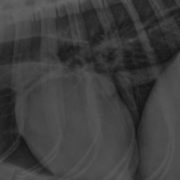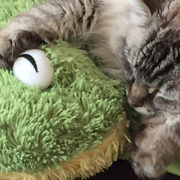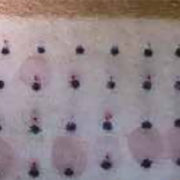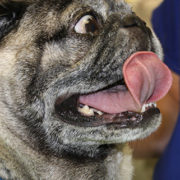Dexmedetomidine use in small animal surgery
Andrea Looney, DVM, DACVAA, CCRP, DACVSMR
Ethos Veterinary Health, Inc.
Posted on 2017-04-11 in Anesthesia & Analgesia
Alpha agonist drugs are drugs such as xylazine, medetomidine, romifidine, dexmedetomidine that act on alpha receptors, flight or fight receptors, to mediate pain relief, sedation, arousal, and extremely important day to day functions including blood pressure, hormonal release, renal perfusion, cardiac output and bronchodilation. Dexmedetomidine has more selectivity for alpha two receptors than the older drugs (xylazine) which had equal selectivity for both alpha one and two receptors. Dexmedetomidine binds to the alpha two receptors on presynaptic neurons preventing release of norepinephrine, mediating most of its effects from sedation to increased blood pressure to decreased cardiac output. Peripheral vasoconstriction results in decreased cardiac output visualized as a bradycardia in most patients.
Advantages of using dexmedetomidine in your patients
Dexmedetomidine can be used in many applications for surgical small animal patients, from total injectable anesthesia regimens (Kitty Magic), to premedication, to intraoperative “rescues” to postoperative medications. Some of the largest advantages of using dexmedetomidine in the premedication protocol is that it adds sedation and anxiety loss to pain relief, it reduces the amount of opioid used, it provides its own pain relief, and it adds to blood pressure regulation (vascular tone); dexmedetomidine also helps to drastically reduce the amount of induction and inhalation agent required for surgery (two large liability areas concerning general anesthesia). Dexmedetomidine should not be used in patients which experience clinical bradycardia, hypertension, hypercoagulability or those being treated for cardiac disease. Dexmedetomidine doses range from 0.2-30mcg/kg; the wide range makes possible intraoperative uses (low end of range) through premed doses (mid-range) to injectable regimens (high end of range). Clinically what you will witness with incorporation of dexmedetomidine into your premedication will be lower heart rates, steadier planes of anesthesia, more profound muscle relaxation, and lessened need for isoflurane.
How low can the heart rate get with dexmedetomidine?
Bradycardia seems to be the most worrisome clinical effect of using this drug in practice. There are no established safe low ranges for heart rate for our patients because of the variety of breeds, species, and procedures, as well as preexisting problems which all add variables to the surgical equation. A key point is that the heart rate is too low if hypotension occurs with it and the patient is too deep because of it (depth established via manual signs of anesthesia). If hypotension occurs with bradycardia produced by dexmedetomidine, a good mechanism to treat both is via lowering the inhalant concentration, administering a dose of glycopyrrolate, and warming the patient; consider reversal ONLY if these fixes do not solve the problem.
References
- Gertler R et al. 2001. Dexmedetomidine a novel sedative analgesic agent.
- Ko JC et al. 2009. FAQs analgesia, sedation and anesthesia; making the switch from medetomidine to dexmedetomidine.
About the author
Dr. Looney joined the IVG network of hospitals in 2014 to develop and expand anesthesia services at all of the hospitals in our network. Her special interests include interventional pain management, rehabilitation, palliative care, postoperative care and anesthesiology. |


 Dr. Looney graduated from Cornell University’s College of Veterinary Medicine in 1989. She spent a year in private practice, then returned to Cornell’s small animal hospital for an instructorship in Community Medicine and Anesthesiology. In 1997 she completed a Residency in Anesthesiology and became boarded in Anesthesiology in 2001. Post residency, Dr. Looney held positions with Angell/MSPCA Animal Medical Center in Boston and Springfield, MA in Intensive Care, Anesthesiology and General Medicine, Tufts Cummings School of Veterinary Medicine and Tufts Veterinary Emergency Treatment and Specialties as Hospital Director and Assistant Clinical Professor, and most recently Cornell University’s College of Veterinary Medicine where she spearheaded the Pain Management and Rehabilitation Service for both large and small animals.
Dr. Looney graduated from Cornell University’s College of Veterinary Medicine in 1989. She spent a year in private practice, then returned to Cornell’s small animal hospital for an instructorship in Community Medicine and Anesthesiology. In 1997 she completed a Residency in Anesthesiology and became boarded in Anesthesiology in 2001. Post residency, Dr. Looney held positions with Angell/MSPCA Animal Medical Center in Boston and Springfield, MA in Intensive Care, Anesthesiology and General Medicine, Tufts Cummings School of Veterinary Medicine and Tufts Veterinary Emergency Treatment and Specialties as Hospital Director and Assistant Clinical Professor, and most recently Cornell University’s College of Veterinary Medicine where she spearheaded the Pain Management and Rehabilitation Service for both large and small animals.








